Leadership Styles and Quality of Teaching
VerifiedAdded on 2020/10/04
|9
|2855
|273
AI Summary
This assignment discusses the various leadership styles, including autocratic, democratic, contingency, and transformational theories, and their effects on the quality of teaching and learning in schools. It examines how these styles motivate employees, influence job satisfaction, and impact performance. The report concludes that choosing the right leadership style is crucial for achieving maximum output from teachers and students.
Contribute Materials
Your contribution can guide someone’s learning journey. Share your
documents today.
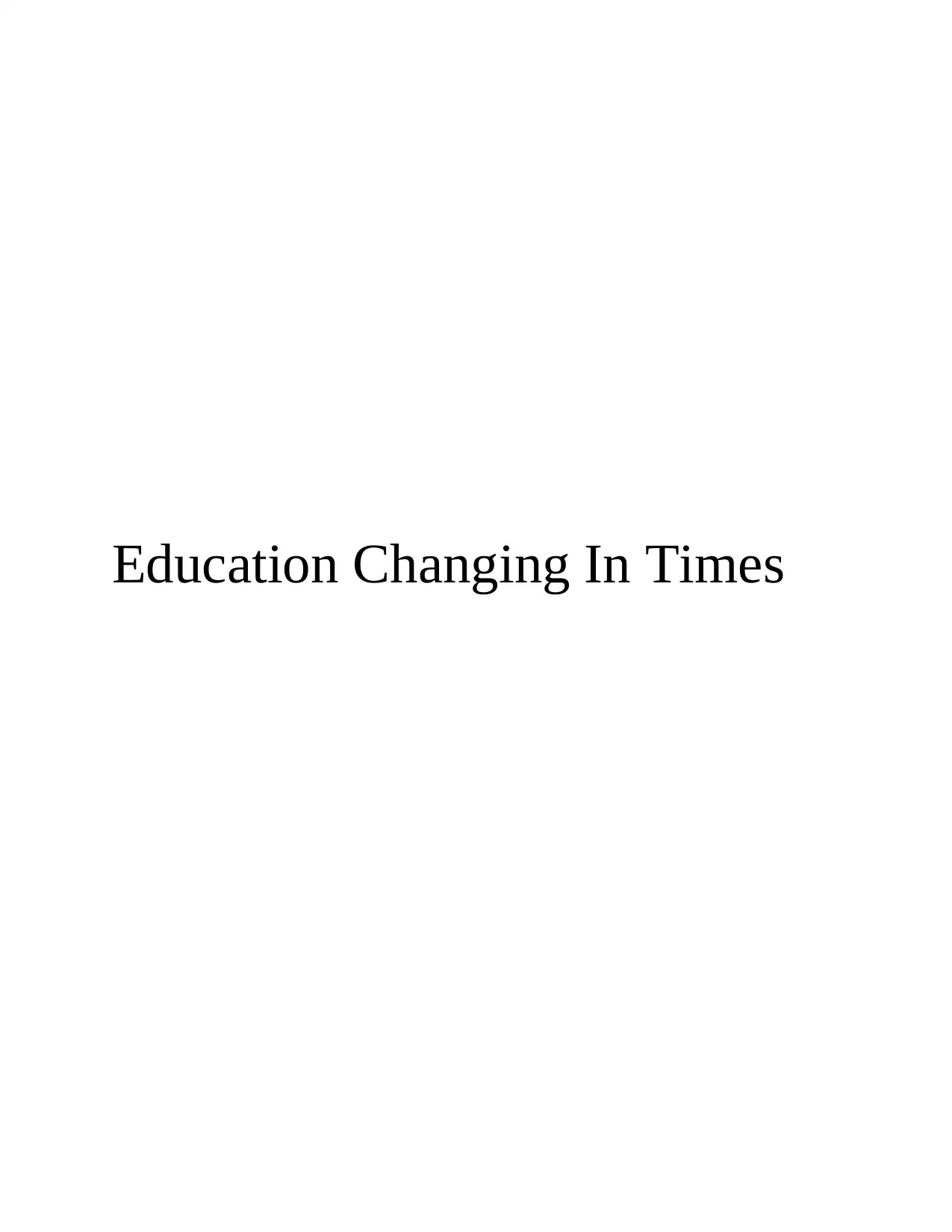
Education Changing In Times
Secure Best Marks with AI Grader
Need help grading? Try our AI Grader for instant feedback on your assignments.
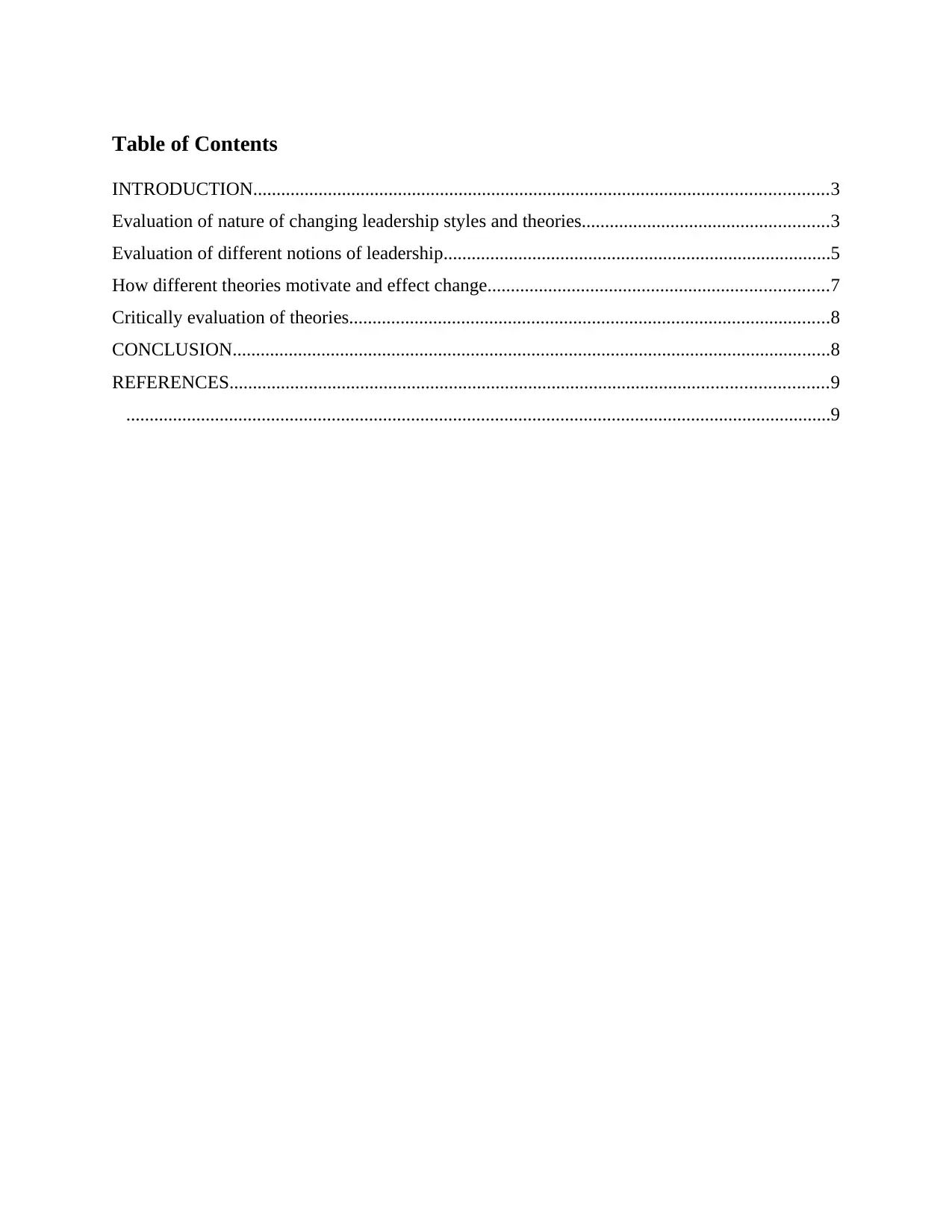
Table of Contents
INTRODUCTION...........................................................................................................................3
Evaluation of nature of changing leadership styles and theories.....................................................3
Evaluation of different notions of leadership...................................................................................5
How different theories motivate and effect change.........................................................................7
Critically evaluation of theories.......................................................................................................8
CONCLUSION................................................................................................................................8
REFERENCES................................................................................................................................9
.......................................................................................................................................................9
INTRODUCTION...........................................................................................................................3
Evaluation of nature of changing leadership styles and theories.....................................................3
Evaluation of different notions of leadership...................................................................................5
How different theories motivate and effect change.........................................................................7
Critically evaluation of theories.......................................................................................................8
CONCLUSION................................................................................................................................8
REFERENCES................................................................................................................................9
.......................................................................................................................................................9
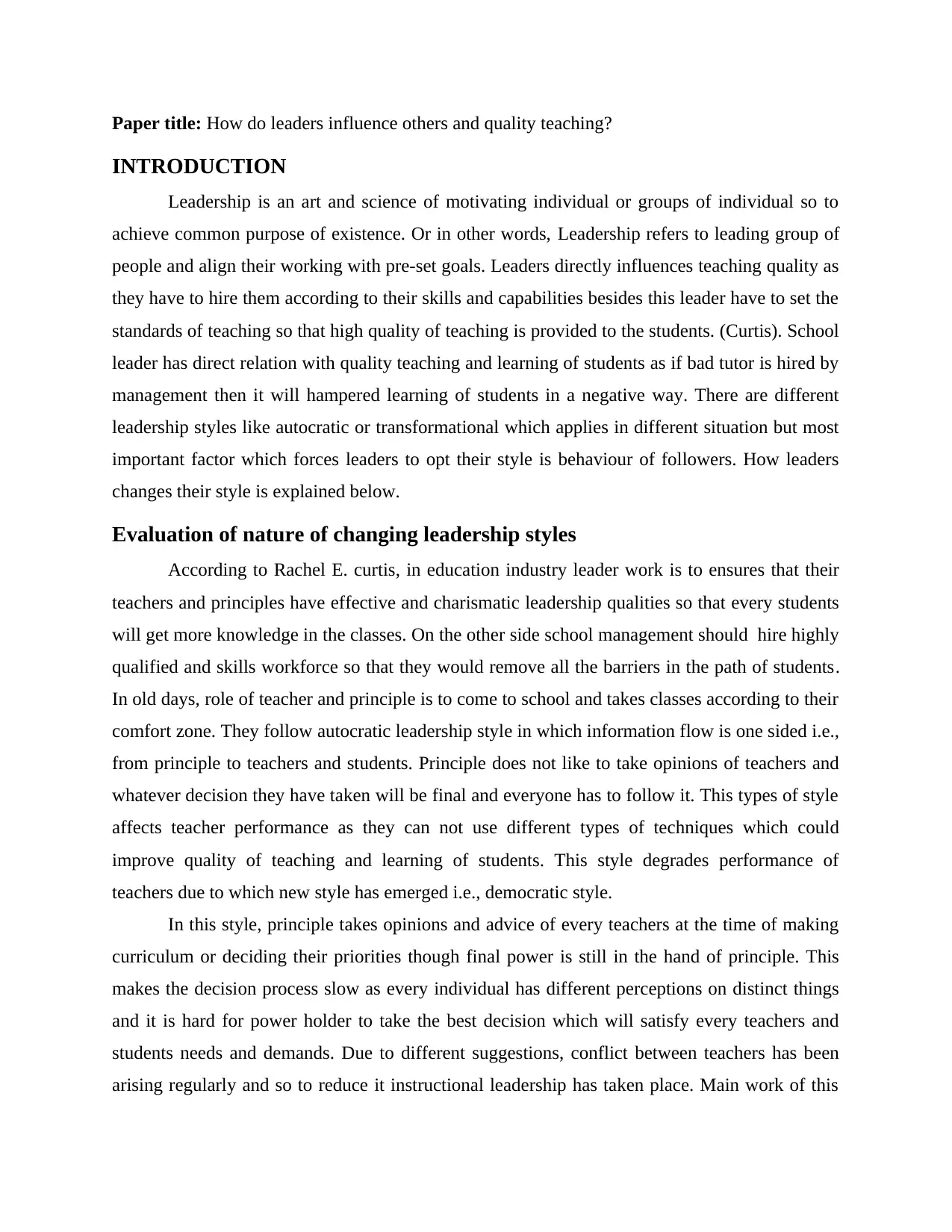
Paper title: How do leaders influence others and quality teaching?
INTRODUCTION
Leadership is an art and science of motivating individual or groups of individual so to
achieve common purpose of existence. Or in other words, Leadership refers to leading group of
people and align their working with pre-set goals. Leaders directly influences teaching quality as
they have to hire them according to their skills and capabilities besides this leader have to set the
standards of teaching so that high quality of teaching is provided to the students. (Curtis). School
leader has direct relation with quality teaching and learning of students as if bad tutor is hired by
management then it will hampered learning of students in a negative way. There are different
leadership styles like autocratic or transformational which applies in different situation but most
important factor which forces leaders to opt their style is behaviour of followers. How leaders
changes their style is explained below.
Evaluation of nature of changing leadership styles
According to Rachel E. curtis, in education industry leader work is to ensures that their
teachers and principles have effective and charismatic leadership qualities so that every students
will get more knowledge in the classes. On the other side school management should hire highly
qualified and skills workforce so that they would remove all the barriers in the path of students.
In old days, role of teacher and principle is to come to school and takes classes according to their
comfort zone. They follow autocratic leadership style in which information flow is one sided i.e.,
from principle to teachers and students. Principle does not like to take opinions of teachers and
whatever decision they have taken will be final and everyone has to follow it. This types of style
affects teacher performance as they can not use different types of techniques which could
improve quality of teaching and learning of students. This style degrades performance of
teachers due to which new style has emerged i.e., democratic style.
In this style, principle takes opinions and advice of every teachers at the time of making
curriculum or deciding their priorities though final power is still in the hand of principle. This
makes the decision process slow as every individual has different perceptions on distinct things
and it is hard for power holder to take the best decision which will satisfy every teachers and
students needs and demands. Due to different suggestions, conflict between teachers has been
arising regularly and so to reduce it instructional leadership has taken place. Main work of this
INTRODUCTION
Leadership is an art and science of motivating individual or groups of individual so to
achieve common purpose of existence. Or in other words, Leadership refers to leading group of
people and align their working with pre-set goals. Leaders directly influences teaching quality as
they have to hire them according to their skills and capabilities besides this leader have to set the
standards of teaching so that high quality of teaching is provided to the students. (Curtis). School
leader has direct relation with quality teaching and learning of students as if bad tutor is hired by
management then it will hampered learning of students in a negative way. There are different
leadership styles like autocratic or transformational which applies in different situation but most
important factor which forces leaders to opt their style is behaviour of followers. How leaders
changes their style is explained below.
Evaluation of nature of changing leadership styles
According to Rachel E. curtis, in education industry leader work is to ensures that their
teachers and principles have effective and charismatic leadership qualities so that every students
will get more knowledge in the classes. On the other side school management should hire highly
qualified and skills workforce so that they would remove all the barriers in the path of students.
In old days, role of teacher and principle is to come to school and takes classes according to their
comfort zone. They follow autocratic leadership style in which information flow is one sided i.e.,
from principle to teachers and students. Principle does not like to take opinions of teachers and
whatever decision they have taken will be final and everyone has to follow it. This types of style
affects teacher performance as they can not use different types of techniques which could
improve quality of teaching and learning of students. This style degrades performance of
teachers due to which new style has emerged i.e., democratic style.
In this style, principle takes opinions and advice of every teachers at the time of making
curriculum or deciding their priorities though final power is still in the hand of principle. This
makes the decision process slow as every individual has different perceptions on distinct things
and it is hard for power holder to take the best decision which will satisfy every teachers and
students needs and demands. Due to different suggestions, conflict between teachers has been
arising regularly and so to reduce it instructional leadership has taken place. Main work of this
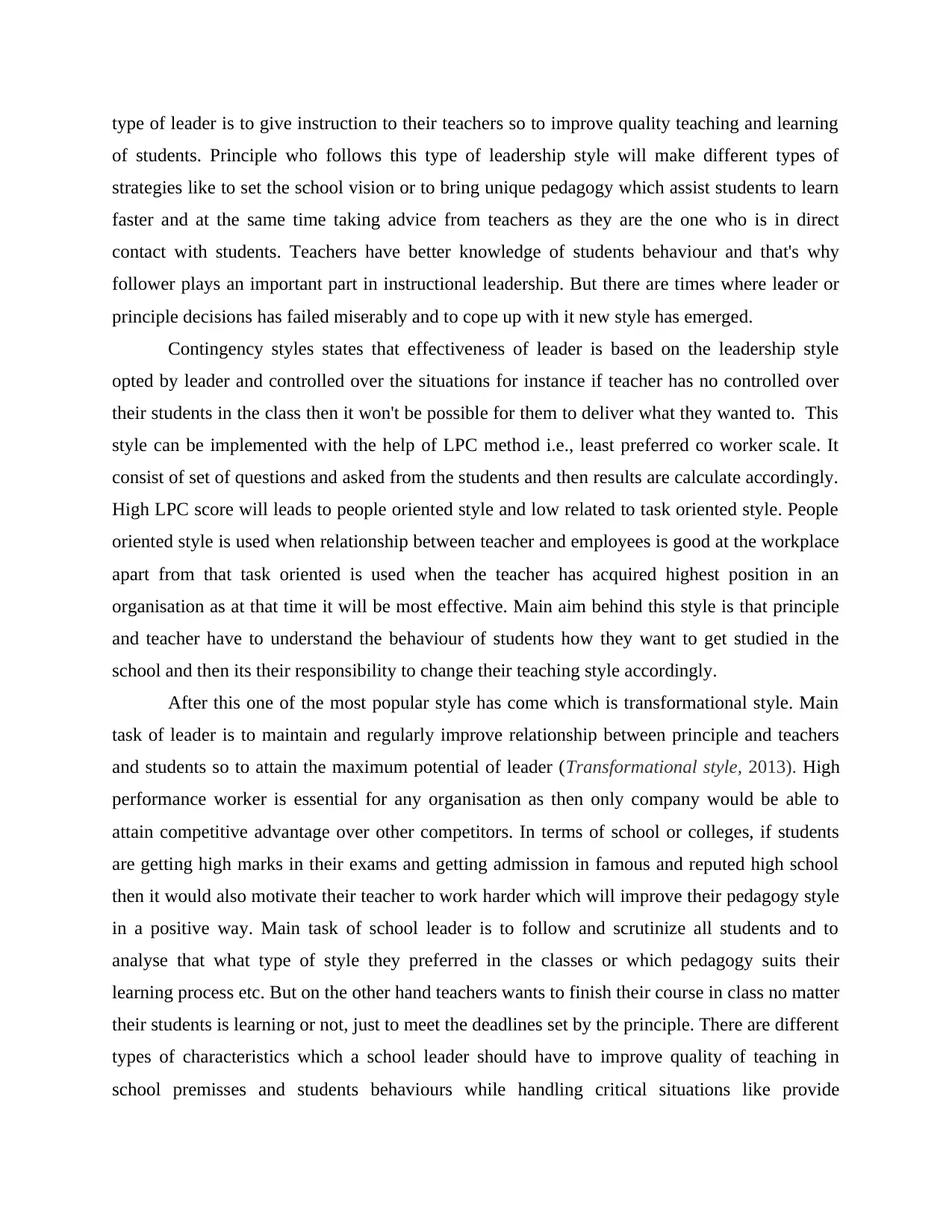
type of leader is to give instruction to their teachers so to improve quality teaching and learning
of students. Principle who follows this type of leadership style will make different types of
strategies like to set the school vision or to bring unique pedagogy which assist students to learn
faster and at the same time taking advice from teachers as they are the one who is in direct
contact with students. Teachers have better knowledge of students behaviour and that's why
follower plays an important part in instructional leadership. But there are times where leader or
principle decisions has failed miserably and to cope up with it new style has emerged.
Contingency styles states that effectiveness of leader is based on the leadership style
opted by leader and controlled over the situations for instance if teacher has no controlled over
their students in the class then it won't be possible for them to deliver what they wanted to. This
style can be implemented with the help of LPC method i.e., least preferred co worker scale. It
consist of set of questions and asked from the students and then results are calculate accordingly.
High LPC score will leads to people oriented style and low related to task oriented style. People
oriented style is used when relationship between teacher and employees is good at the workplace
apart from that task oriented is used when the teacher has acquired highest position in an
organisation as at that time it will be most effective. Main aim behind this style is that principle
and teacher have to understand the behaviour of students how they want to get studied in the
school and then its their responsibility to change their teaching style accordingly.
After this one of the most popular style has come which is transformational style. Main
task of leader is to maintain and regularly improve relationship between principle and teachers
and students so to attain the maximum potential of leader (Transformational style, 2013). High
performance worker is essential for any organisation as then only company would be able to
attain competitive advantage over other competitors. In terms of school or colleges, if students
are getting high marks in their exams and getting admission in famous and reputed high school
then it would also motivate their teacher to work harder which will improve their pedagogy style
in a positive way. Main task of school leader is to follow and scrutinize all students and to
analyse that what type of style they preferred in the classes or which pedagogy suits their
learning process etc. But on the other hand teachers wants to finish their course in class no matter
their students is learning or not, just to meet the deadlines set by the principle. There are different
types of characteristics which a school leader should have to improve quality of teaching in
school premisses and students behaviours while handling critical situations like provide
of students. Principle who follows this type of leadership style will make different types of
strategies like to set the school vision or to bring unique pedagogy which assist students to learn
faster and at the same time taking advice from teachers as they are the one who is in direct
contact with students. Teachers have better knowledge of students behaviour and that's why
follower plays an important part in instructional leadership. But there are times where leader or
principle decisions has failed miserably and to cope up with it new style has emerged.
Contingency styles states that effectiveness of leader is based on the leadership style
opted by leader and controlled over the situations for instance if teacher has no controlled over
their students in the class then it won't be possible for them to deliver what they wanted to. This
style can be implemented with the help of LPC method i.e., least preferred co worker scale. It
consist of set of questions and asked from the students and then results are calculate accordingly.
High LPC score will leads to people oriented style and low related to task oriented style. People
oriented style is used when relationship between teacher and employees is good at the workplace
apart from that task oriented is used when the teacher has acquired highest position in an
organisation as at that time it will be most effective. Main aim behind this style is that principle
and teacher have to understand the behaviour of students how they want to get studied in the
school and then its their responsibility to change their teaching style accordingly.
After this one of the most popular style has come which is transformational style. Main
task of leader is to maintain and regularly improve relationship between principle and teachers
and students so to attain the maximum potential of leader (Transformational style, 2013). High
performance worker is essential for any organisation as then only company would be able to
attain competitive advantage over other competitors. In terms of school or colleges, if students
are getting high marks in their exams and getting admission in famous and reputed high school
then it would also motivate their teacher to work harder which will improve their pedagogy style
in a positive way. Main task of school leader is to follow and scrutinize all students and to
analyse that what type of style they preferred in the classes or which pedagogy suits their
learning process etc. But on the other hand teachers wants to finish their course in class no matter
their students is learning or not, just to meet the deadlines set by the principle. There are different
types of characteristics which a school leader should have to improve quality of teaching in
school premisses and students behaviours while handling critical situations like provide
Secure Best Marks with AI Grader
Need help grading? Try our AI Grader for instant feedback on your assignments.
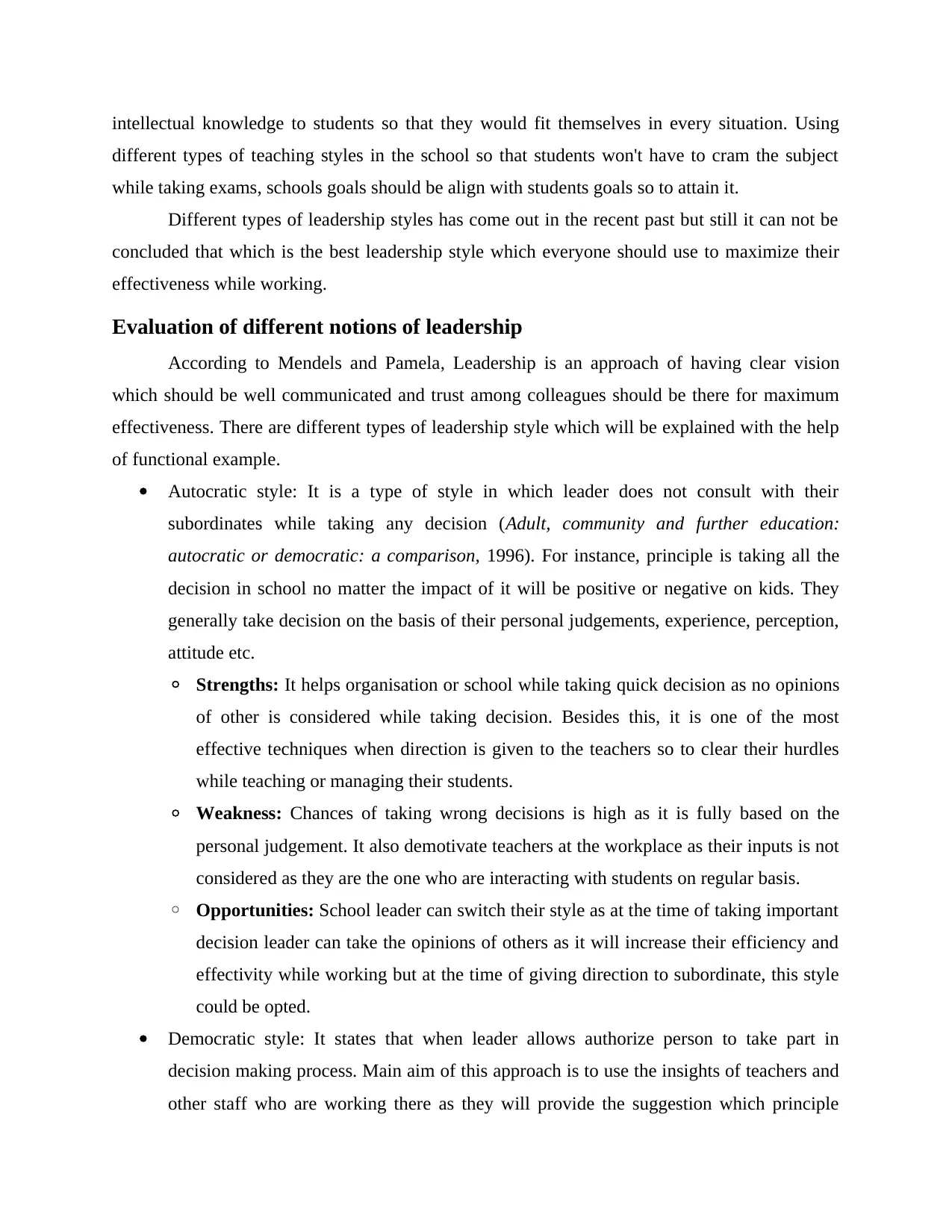
intellectual knowledge to students so that they would fit themselves in every situation. Using
different types of teaching styles in the school so that students won't have to cram the subject
while taking exams, schools goals should be align with students goals so to attain it.
Different types of leadership styles has come out in the recent past but still it can not be
concluded that which is the best leadership style which everyone should use to maximize their
effectiveness while working.
Evaluation of different notions of leadership
According to Mendels and Pamela, Leadership is an approach of having clear vision
which should be well communicated and trust among colleagues should be there for maximum
effectiveness. There are different types of leadership style which will be explained with the help
of functional example.
Autocratic style: It is a type of style in which leader does not consult with their
subordinates while taking any decision (Adult, community and further education:
autocratic or democratic: a comparison, 1996). For instance, principle is taking all the
decision in school no matter the impact of it will be positive or negative on kids. They
generally take decision on the basis of their personal judgements, experience, perception,
attitude etc.
◦ Strengths: It helps organisation or school while taking quick decision as no opinions
of other is considered while taking decision. Besides this, it is one of the most
effective techniques when direction is given to the teachers so to clear their hurdles
while teaching or managing their students.
◦ Weakness: Chances of taking wrong decisions is high as it is fully based on the
personal judgement. It also demotivate teachers at the workplace as their inputs is not
considered as they are the one who are interacting with students on regular basis.
◦ Opportunities: School leader can switch their style as at the time of taking important
decision leader can take the opinions of others as it will increase their efficiency and
effectivity while working but at the time of giving direction to subordinate, this style
could be opted.
Democratic style: It states that when leader allows authorize person to take part in
decision making process. Main aim of this approach is to use the insights of teachers and
other staff who are working there as they will provide the suggestion which principle
different types of teaching styles in the school so that students won't have to cram the subject
while taking exams, schools goals should be align with students goals so to attain it.
Different types of leadership styles has come out in the recent past but still it can not be
concluded that which is the best leadership style which everyone should use to maximize their
effectiveness while working.
Evaluation of different notions of leadership
According to Mendels and Pamela, Leadership is an approach of having clear vision
which should be well communicated and trust among colleagues should be there for maximum
effectiveness. There are different types of leadership style which will be explained with the help
of functional example.
Autocratic style: It is a type of style in which leader does not consult with their
subordinates while taking any decision (Adult, community and further education:
autocratic or democratic: a comparison, 1996). For instance, principle is taking all the
decision in school no matter the impact of it will be positive or negative on kids. They
generally take decision on the basis of their personal judgements, experience, perception,
attitude etc.
◦ Strengths: It helps organisation or school while taking quick decision as no opinions
of other is considered while taking decision. Besides this, it is one of the most
effective techniques when direction is given to the teachers so to clear their hurdles
while teaching or managing their students.
◦ Weakness: Chances of taking wrong decisions is high as it is fully based on the
personal judgement. It also demotivate teachers at the workplace as their inputs is not
considered as they are the one who are interacting with students on regular basis.
◦ Opportunities: School leader can switch their style as at the time of taking important
decision leader can take the opinions of others as it will increase their efficiency and
effectivity while working but at the time of giving direction to subordinate, this style
could be opted.
Democratic style: It states that when leader allows authorize person to take part in
decision making process. Main aim of this approach is to use the insights of teachers and
other staff who are working there as they will provide the suggestion which principle
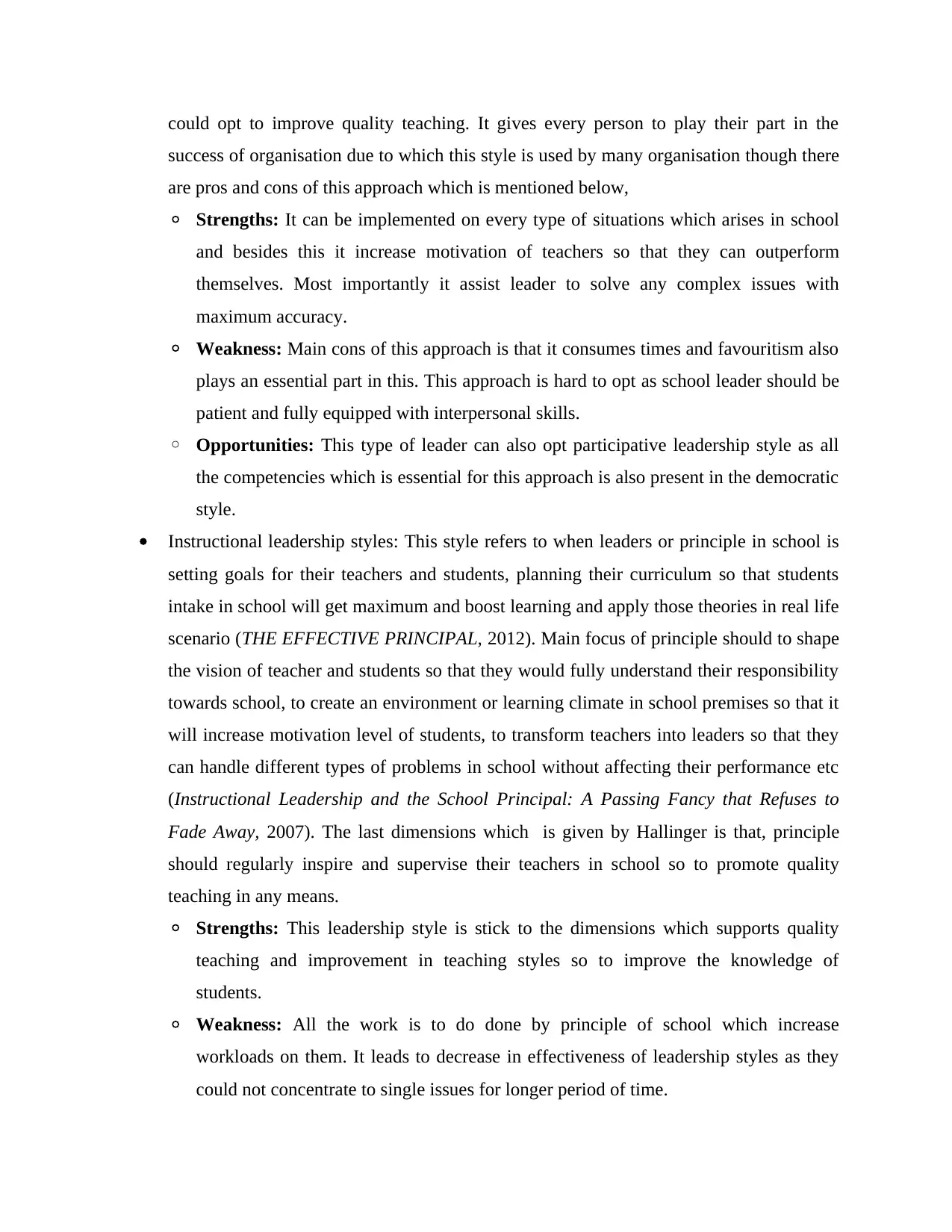
could opt to improve quality teaching. It gives every person to play their part in the
success of organisation due to which this style is used by many organisation though there
are pros and cons of this approach which is mentioned below,
◦ Strengths: It can be implemented on every type of situations which arises in school
and besides this it increase motivation of teachers so that they can outperform
themselves. Most importantly it assist leader to solve any complex issues with
maximum accuracy.
◦ Weakness: Main cons of this approach is that it consumes times and favouritism also
plays an essential part in this. This approach is hard to opt as school leader should be
patient and fully equipped with interpersonal skills.
◦ Opportunities: This type of leader can also opt participative leadership style as all
the competencies which is essential for this approach is also present in the democratic
style.
Instructional leadership styles: This style refers to when leaders or principle in school is
setting goals for their teachers and students, planning their curriculum so that students
intake in school will get maximum and boost learning and apply those theories in real life
scenario (THE EFFECTIVE PRINCIPAL, 2012). Main focus of principle should to shape
the vision of teacher and students so that they would fully understand their responsibility
towards school, to create an environment or learning climate in school premises so that it
will increase motivation level of students, to transform teachers into leaders so that they
can handle different types of problems in school without affecting their performance etc
(Instructional Leadership and the School Principal: A Passing Fancy that Refuses to
Fade Away, 2007). The last dimensions which is given by Hallinger is that, principle
should regularly inspire and supervise their teachers in school so to promote quality
teaching in any means.
◦ Strengths: This leadership style is stick to the dimensions which supports quality
teaching and improvement in teaching styles so to improve the knowledge of
students.
◦ Weakness: All the work is to do done by principle of school which increase
workloads on them. It leads to decrease in effectiveness of leadership styles as they
could not concentrate to single issues for longer period of time.
success of organisation due to which this style is used by many organisation though there
are pros and cons of this approach which is mentioned below,
◦ Strengths: It can be implemented on every type of situations which arises in school
and besides this it increase motivation of teachers so that they can outperform
themselves. Most importantly it assist leader to solve any complex issues with
maximum accuracy.
◦ Weakness: Main cons of this approach is that it consumes times and favouritism also
plays an essential part in this. This approach is hard to opt as school leader should be
patient and fully equipped with interpersonal skills.
◦ Opportunities: This type of leader can also opt participative leadership style as all
the competencies which is essential for this approach is also present in the democratic
style.
Instructional leadership styles: This style refers to when leaders or principle in school is
setting goals for their teachers and students, planning their curriculum so that students
intake in school will get maximum and boost learning and apply those theories in real life
scenario (THE EFFECTIVE PRINCIPAL, 2012). Main focus of principle should to shape
the vision of teacher and students so that they would fully understand their responsibility
towards school, to create an environment or learning climate in school premises so that it
will increase motivation level of students, to transform teachers into leaders so that they
can handle different types of problems in school without affecting their performance etc
(Instructional Leadership and the School Principal: A Passing Fancy that Refuses to
Fade Away, 2007). The last dimensions which is given by Hallinger is that, principle
should regularly inspire and supervise their teachers in school so to promote quality
teaching in any means.
◦ Strengths: This leadership style is stick to the dimensions which supports quality
teaching and improvement in teaching styles so to improve the knowledge of
students.
◦ Weakness: All the work is to do done by principle of school which increase
workloads on them. It leads to decrease in effectiveness of leadership styles as they
could not concentrate to single issues for longer period of time.
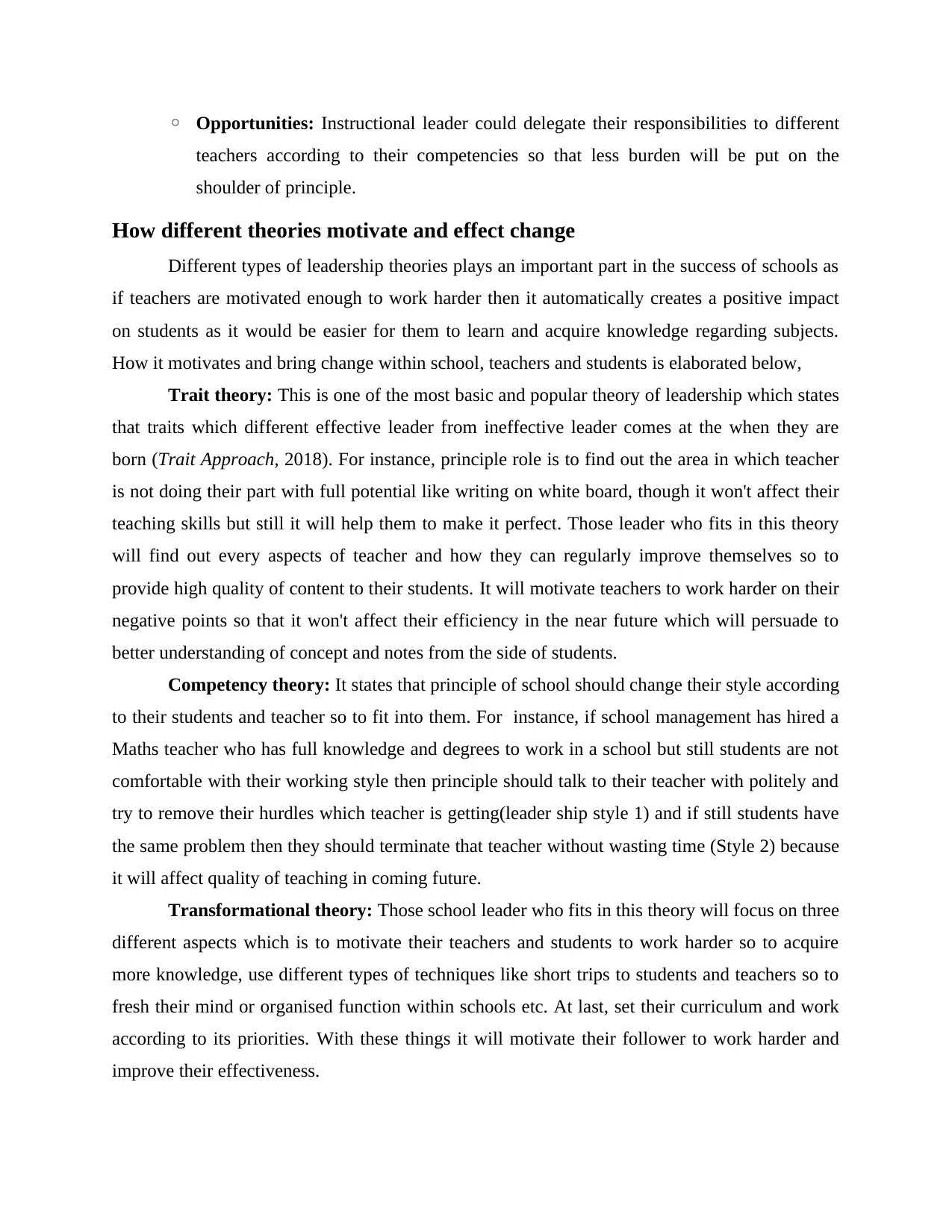
◦ Opportunities: Instructional leader could delegate their responsibilities to different
teachers according to their competencies so that less burden will be put on the
shoulder of principle.
How different theories motivate and effect change
Different types of leadership theories plays an important part in the success of schools as
if teachers are motivated enough to work harder then it automatically creates a positive impact
on students as it would be easier for them to learn and acquire knowledge regarding subjects.
How it motivates and bring change within school, teachers and students is elaborated below,
Trait theory: This is one of the most basic and popular theory of leadership which states
that traits which different effective leader from ineffective leader comes at the when they are
born (Trait Approach, 2018). For instance, principle role is to find out the area in which teacher
is not doing their part with full potential like writing on white board, though it won't affect their
teaching skills but still it will help them to make it perfect. Those leader who fits in this theory
will find out every aspects of teacher and how they can regularly improve themselves so to
provide high quality of content to their students. It will motivate teachers to work harder on their
negative points so that it won't affect their efficiency in the near future which will persuade to
better understanding of concept and notes from the side of students.
Competency theory: It states that principle of school should change their style according
to their students and teacher so to fit into them. For instance, if school management has hired a
Maths teacher who has full knowledge and degrees to work in a school but still students are not
comfortable with their working style then principle should talk to their teacher with politely and
try to remove their hurdles which teacher is getting(leader ship style 1) and if still students have
the same problem then they should terminate that teacher without wasting time (Style 2) because
it will affect quality of teaching in coming future.
Transformational theory: Those school leader who fits in this theory will focus on three
different aspects which is to motivate their teachers and students to work harder so to acquire
more knowledge, use different types of techniques like short trips to students and teachers so to
fresh their mind or organised function within schools etc. At last, set their curriculum and work
according to its priorities. With these things it will motivate their follower to work harder and
improve their effectiveness.
teachers according to their competencies so that less burden will be put on the
shoulder of principle.
How different theories motivate and effect change
Different types of leadership theories plays an important part in the success of schools as
if teachers are motivated enough to work harder then it automatically creates a positive impact
on students as it would be easier for them to learn and acquire knowledge regarding subjects.
How it motivates and bring change within school, teachers and students is elaborated below,
Trait theory: This is one of the most basic and popular theory of leadership which states
that traits which different effective leader from ineffective leader comes at the when they are
born (Trait Approach, 2018). For instance, principle role is to find out the area in which teacher
is not doing their part with full potential like writing on white board, though it won't affect their
teaching skills but still it will help them to make it perfect. Those leader who fits in this theory
will find out every aspects of teacher and how they can regularly improve themselves so to
provide high quality of content to their students. It will motivate teachers to work harder on their
negative points so that it won't affect their efficiency in the near future which will persuade to
better understanding of concept and notes from the side of students.
Competency theory: It states that principle of school should change their style according
to their students and teacher so to fit into them. For instance, if school management has hired a
Maths teacher who has full knowledge and degrees to work in a school but still students are not
comfortable with their working style then principle should talk to their teacher with politely and
try to remove their hurdles which teacher is getting(leader ship style 1) and if still students have
the same problem then they should terminate that teacher without wasting time (Style 2) because
it will affect quality of teaching in coming future.
Transformational theory: Those school leader who fits in this theory will focus on three
different aspects which is to motivate their teachers and students to work harder so to acquire
more knowledge, use different types of techniques like short trips to students and teachers so to
fresh their mind or organised function within schools etc. At last, set their curriculum and work
according to its priorities. With these things it will motivate their follower to work harder and
improve their effectiveness.
Paraphrase This Document
Need a fresh take? Get an instant paraphrase of this document with our AI Paraphraser
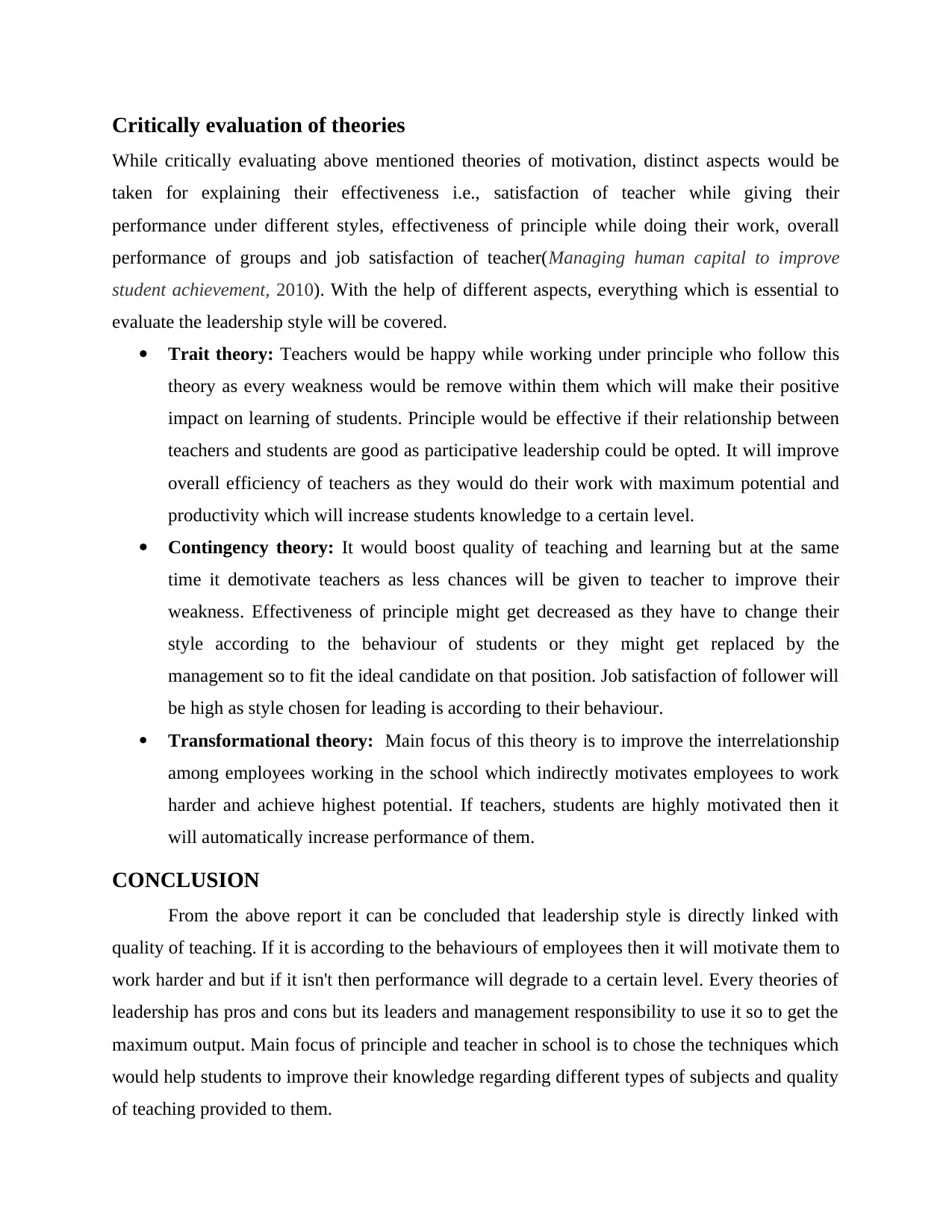
Critically evaluation of theories
While critically evaluating above mentioned theories of motivation, distinct aspects would be
taken for explaining their effectiveness i.e., satisfaction of teacher while giving their
performance under different styles, effectiveness of principle while doing their work, overall
performance of groups and job satisfaction of teacher(Managing human capital to improve
student achievement, 2010). With the help of different aspects, everything which is essential to
evaluate the leadership style will be covered.
Trait theory: Teachers would be happy while working under principle who follow this
theory as every weakness would be remove within them which will make their positive
impact on learning of students. Principle would be effective if their relationship between
teachers and students are good as participative leadership could be opted. It will improve
overall efficiency of teachers as they would do their work with maximum potential and
productivity which will increase students knowledge to a certain level.
Contingency theory: It would boost quality of teaching and learning but at the same
time it demotivate teachers as less chances will be given to teacher to improve their
weakness. Effectiveness of principle might get decreased as they have to change their
style according to the behaviour of students or they might get replaced by the
management so to fit the ideal candidate on that position. Job satisfaction of follower will
be high as style chosen for leading is according to their behaviour.
Transformational theory: Main focus of this theory is to improve the interrelationship
among employees working in the school which indirectly motivates employees to work
harder and achieve highest potential. If teachers, students are highly motivated then it
will automatically increase performance of them.
CONCLUSION
From the above report it can be concluded that leadership style is directly linked with
quality of teaching. If it is according to the behaviours of employees then it will motivate them to
work harder and but if it isn't then performance will degrade to a certain level. Every theories of
leadership has pros and cons but its leaders and management responsibility to use it so to get the
maximum output. Main focus of principle and teacher in school is to chose the techniques which
would help students to improve their knowledge regarding different types of subjects and quality
of teaching provided to them.
While critically evaluating above mentioned theories of motivation, distinct aspects would be
taken for explaining their effectiveness i.e., satisfaction of teacher while giving their
performance under different styles, effectiveness of principle while doing their work, overall
performance of groups and job satisfaction of teacher(Managing human capital to improve
student achievement, 2010). With the help of different aspects, everything which is essential to
evaluate the leadership style will be covered.
Trait theory: Teachers would be happy while working under principle who follow this
theory as every weakness would be remove within them which will make their positive
impact on learning of students. Principle would be effective if their relationship between
teachers and students are good as participative leadership could be opted. It will improve
overall efficiency of teachers as they would do their work with maximum potential and
productivity which will increase students knowledge to a certain level.
Contingency theory: It would boost quality of teaching and learning but at the same
time it demotivate teachers as less chances will be given to teacher to improve their
weakness. Effectiveness of principle might get decreased as they have to change their
style according to the behaviour of students or they might get replaced by the
management so to fit the ideal candidate on that position. Job satisfaction of follower will
be high as style chosen for leading is according to their behaviour.
Transformational theory: Main focus of this theory is to improve the interrelationship
among employees working in the school which indirectly motivates employees to work
harder and achieve highest potential. If teachers, students are highly motivated then it
will automatically increase performance of them.
CONCLUSION
From the above report it can be concluded that leadership style is directly linked with
quality of teaching. If it is according to the behaviours of employees then it will motivate them to
work harder and but if it isn't then performance will degrade to a certain level. Every theories of
leadership has pros and cons but its leaders and management responsibility to use it so to get the
maximum output. Main focus of principle and teacher in school is to chose the techniques which
would help students to improve their knowledge regarding different types of subjects and quality
of teaching provided to them.
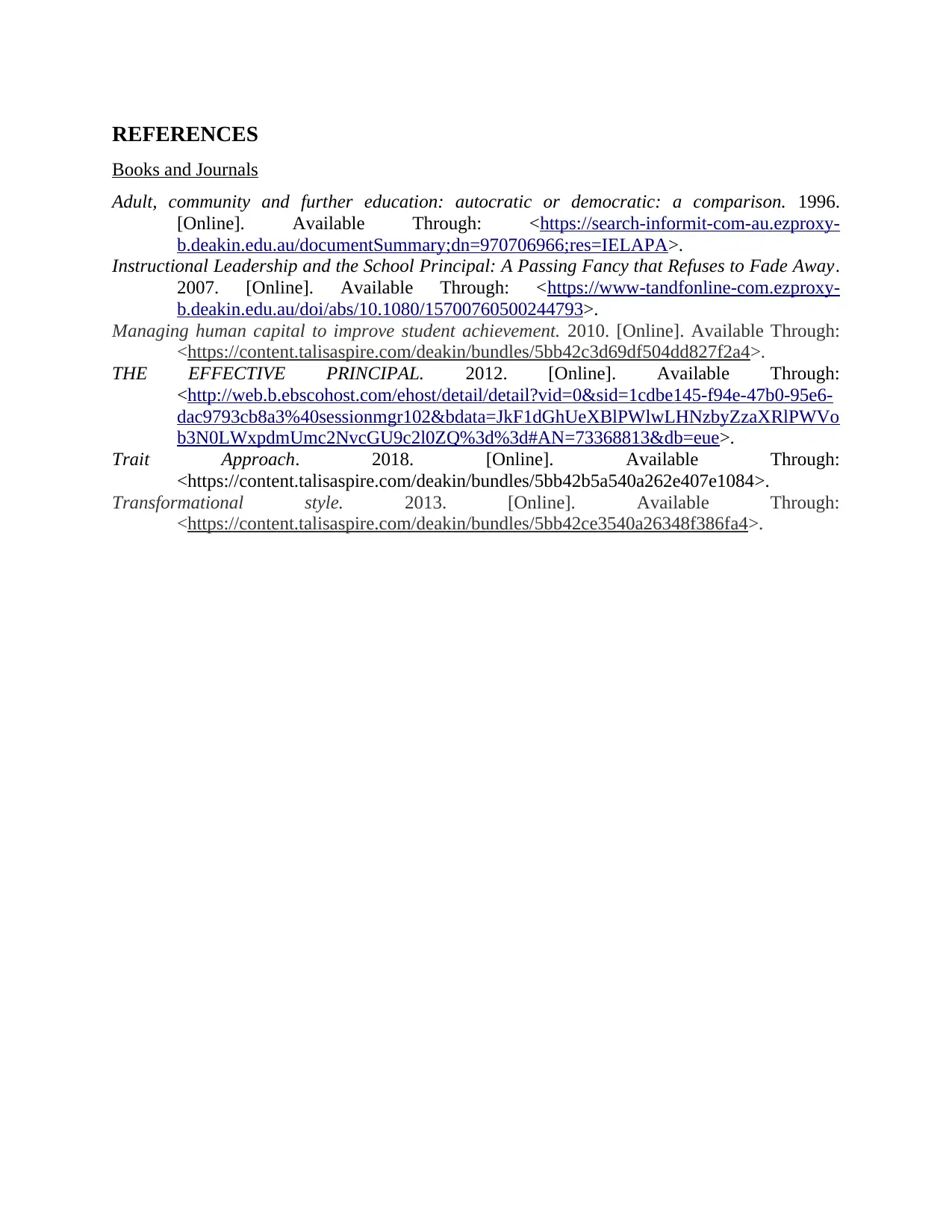
REFERENCES
Books and Journals
Adult, community and further education: autocratic or democratic: a comparison. 1996.
[Online]. Available Through: <https://search-informit-com-au.ezproxy-
b.deakin.edu.au/documentSummary;dn=970706966;res=IELAPA>.
Instructional Leadership and the School Principal: A Passing Fancy that Refuses to Fade Away.
2007. [Online]. Available Through: <https://www-tandfonline-com.ezproxy-
b.deakin.edu.au/doi/abs/10.1080/15700760500244793>.
Managing human capital to improve student achievement. 2010. [Online]. Available Through:
<https://content.talisaspire.com/deakin/bundles/5bb42c3d69df504dd827f2a4>.
THE EFFECTIVE PRINCIPAL. 2012. [Online]. Available Through:
<http://web.b.ebscohost.com/ehost/detail/detail?vid=0&sid=1cdbe145-f94e-47b0-95e6-
dac9793cb8a3%40sessionmgr102&bdata=JkF1dGhUeXBlPWlwLHNzbyZzaXRlPWVo
b3N0LWxpdmUmc2NvcGU9c2l0ZQ%3d%3d#AN=73368813&db=eue>.
Trait Approach. 2018. [Online]. Available Through:
<https://content.talisaspire.com/deakin/bundles/5bb42b5a540a262e407e1084>.
Transformational style. 2013. [Online]. Available Through:
<https://content.talisaspire.com/deakin/bundles/5bb42ce3540a26348f386fa4>.
Books and Journals
Adult, community and further education: autocratic or democratic: a comparison. 1996.
[Online]. Available Through: <https://search-informit-com-au.ezproxy-
b.deakin.edu.au/documentSummary;dn=970706966;res=IELAPA>.
Instructional Leadership and the School Principal: A Passing Fancy that Refuses to Fade Away.
2007. [Online]. Available Through: <https://www-tandfonline-com.ezproxy-
b.deakin.edu.au/doi/abs/10.1080/15700760500244793>.
Managing human capital to improve student achievement. 2010. [Online]. Available Through:
<https://content.talisaspire.com/deakin/bundles/5bb42c3d69df504dd827f2a4>.
THE EFFECTIVE PRINCIPAL. 2012. [Online]. Available Through:
<http://web.b.ebscohost.com/ehost/detail/detail?vid=0&sid=1cdbe145-f94e-47b0-95e6-
dac9793cb8a3%40sessionmgr102&bdata=JkF1dGhUeXBlPWlwLHNzbyZzaXRlPWVo
b3N0LWxpdmUmc2NvcGU9c2l0ZQ%3d%3d#AN=73368813&db=eue>.
Trait Approach. 2018. [Online]. Available Through:
<https://content.talisaspire.com/deakin/bundles/5bb42b5a540a262e407e1084>.
Transformational style. 2013. [Online]. Available Through:
<https://content.talisaspire.com/deakin/bundles/5bb42ce3540a26348f386fa4>.
1 out of 9
Related Documents
Your All-in-One AI-Powered Toolkit for Academic Success.
+13062052269
info@desklib.com
Available 24*7 on WhatsApp / Email
![[object Object]](/_next/static/media/star-bottom.7253800d.svg)
Unlock your academic potential
© 2024 | Zucol Services PVT LTD | All rights reserved.





